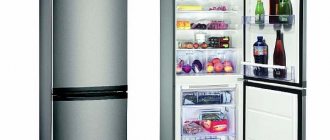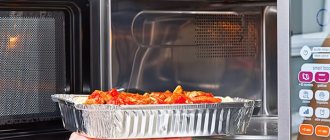Compatibility
The functions performed by the refrigeration unit and the oven are diametrically opposed, which is why it seems that it is impossible to place a microwave on a refrigerator. But this apparent contradiction is not true, since both devices are isolated from the external environment and perform their functions in a closed internal space.
Proof of the peaceful coexistence of a microwave and a refrigerator are reviews from users who have had them peacefully coexist for several years. Therefore, you can put a microwave on a refrigerator, but subject to certain conditions.
This is interesting: Which drum for a washing machine is better: stainless steel or plastic?
Work specifics
You can bet that there is a refrigerator in every kitchen today. The microwave is slightly inferior in popularity, but it also has its admirers. Although the focus of these devices is diametrically opposite, each of them is created in order to make our lives easier.
However, many are afraid to place them next to each other due to the fact that one operates with cold, and the other with high temperatures. However, if you delve into the work process of each of the assistants, you can make sure that the body of each of them is firmly insulated, and the temperature conditions do not extend beyond their walls.
Those. The operation of a microwave oven will not interfere with your refrigerator, and vice versa. Reliable sealing of the case prevents hot air and microwaves from escaping, otherwise everything around would melt and we would feel obvious discomfort.
Therefore, the answer to the question whether a microwave can be placed on top of a refrigerator will be positive. But there are several important nuances that should be taken into account:
- The principle of stove configuration and placement of ventilation in it;
- Regular use of the microwave;
- Unobstructed access to the stove and availability of free space around;
- Refrigerator height.
Now let's talk in more detail about these aspects.
The importance of ventilation
For the device to operate correctly, it requires high-quality ventilation. Otherwise, the microwave oven may soon become unusable. If the ventilation grilles are located on the top cover, they usually write “Do not cover” there, but not everyone pays attention to the fact that ventilation holes can also be located in other places.
Some models have a structure in which the combustion air exits from the side, or even from the bottom. Pay attention to the following indicators:
- 12 cm – minimum distance to the wall;
- 20 cm is the minimum permissible distance to the ceiling.
It would be a mistake to place the refrigerator and microwave in cabinets, thereby limiting air circulation.
In addition, the stove must stand on a flat surface and have an equal distance from it along its entire perimeter. Make sure to build a special plywood stand that can separate the two devices. Strong legs with a height of 3-4 cm are also important, since placement close to each other is unacceptable.
To summarize this point, I would like to draw your attention to the fact that if both devices can breathe freely, then you can safely place the microwave on the refrigerator.
Frequency of operation
For what purposes do you need a microwave oven? Reheating previously prepared food? No problem, in this case its placement can be anything. Indeed, in such situations, its operating time does not exceed five minutes. During this time, it does not heat up too much and will not harm the refrigerator condenser.
If you prefer to use it as a grill or oven, that is, bake food there for a long time, you should choose a different location.
Free access
Nothing should prevent the appliance door from opening, otherwise its main purpose – quick use – will be lost.
In principle, the top cover of the refrigerator is suitable for installing a stove on it if it is level and not cluttered with unnecessary things. However, the height of the refrigeration equipment is also an important point.
Refrigerator height
This criterion will be one of the fundamental indicators. If you have a large two-chamber refrigerator that is taller than you are, don’t even think about putting anything on it:
- The recommended height for installing a microwave oven is 130 cm from the floor or just below your shoulder.
- To use the equipment comfortably, you will have to use auxiliary objects - a chair or stand.
- When taking out hot food from a height, there is a risk of turning it onto yourself and getting burned.
Thus, it becomes clear that the refrigerator must be small in size so that all safety measures are met.
What is written in the instructions
The operating rules of most manufacturers do not provide for the possibility of installing one device on another. The instructions do not say anything about this, but the risks associated with such an arrangement must be taken by the owner of the devices .
The microwave overloads the refrigerator's compressor, causing it to use more electricity. The compartments become warmer, and the engine may wear out prematurely and fail.
If the fact that the microwave oven and refrigerator are adjacent is known to the service department, warranty repairs will most likely be denied. But these actions are illegal if the instructions do not directly prohibit them.
You can minimize the impact of microwaves on the refrigeration chamber by following the rules for its installation. In this case, the devices can work for years without breaking.
Cons: denial of warranty service
Despite the fact that such actions will be considered unlawful, service centers still refuse warranty repairs if they find out that the microwave oven was placed on the refrigerator. Since there is no such prohibition in the instructions, this is illegal.
But if you want to save your time and nerves, then it is better to remain silent about the fact that the microwave was on the freezer.
In what cases can an exception be made?
Placing a microwave oven on the refrigerator body is allowed in the following cases:
- The microwave is used occasionally and no longer than 5-7 minutes in a row. In this case, the equipment and the air around it will not overheat.
- It is possible to ensure normal ventilation of devices. Preference should be given to stove models with ventilation holes on the side or at the top.
- Unhindered access to the microwave will be provided .
To save space, you can purchase a built-in microwave. It is easy to hide behind the facade of the kitchen unit.
Microwave oven on a refrigerator: what is the difficulty?
The main part of microwave ovens is equipped with a special fan, which promotes the circulation of heated air flows when the device is turned on. This helps speed up heating and cooking of food. The microwave has ventilation holes, depending on the manufacturer, they can be located on the sides or on the back of the case, as well as on the bottom.
Related links: How to use the one-third rule in apartment design
The whole difficulty lies precisely in this very hot air. If it cannot escape through the holes, then the device will be forced to undergo constant overheating, which will ultimately inevitably lead to the breakdown of the oven. For this reason, experts recommend installing the microwave in such a way that there is 10-15 cm of space around it. Compliance with this recommendation will prevent overheating and will extend the service life of the device.
Specifics of the device operation
The main thing when placing a microwave oven is to take into account the specifics of its operation. This device emits strong electromagnetic waves around itself. Modern ovens have high-quality screens that block these waves. But some of the radiation still reaches the surface. Therefore, the devices should not be placed near plants or animal cages - the radiation will negatively affect them.
Some models of microwave ovens have ventilation holes on all sides, even at the bottom.
Radiation can damage gas meters, so when using them, the stove must be placed at a distance.
The effect of radiation on people should also be taken into account. It is important not to install the device near places where people spend a long time or where children like to play.
What is the difficulty of placing a microwave oven on a refrigerator?
There are openings on certain parts of the microwave oven that allow air to pass through when the oven is turned on. These holes are responsible for the speed of heating and cooking. Depending on the manufacturers, these holes may be located on different parts of the device, some on the back, others on the sides. There are also manufacturers who have installed microwave vents on the bottom.
The problem with installing a microwave oven is that if the hot air cannot escape, the appliance will constantly overheat and eventually fail. That is why experts advise installing the microwave oven at a distance of ten or fifteen centimeters from other appliances or walls, so that nothing prevents it from functioning and releasing air. If you follow this advice, your microwave oven will last longer.
Safety in use
In order for the device to serve for a long time and bring only benefits to its owners, it is necessary to comply with basic safety requirements. In addition to the installation rules described above, it is important to observe connection security.
Due to the fact that the microwave is a heating device, and the refrigerator is a cooling device, there must be a high-quality thermal insulation layer between them.
Since this device is quite powerful and its connection requires grounding, it must be plugged into a separate outlet. It is prohibited to connect a microwave oven to the same electrical outlet together with other powerful devices: refrigerator, kettle, convection oven, multicooker. This can lead to overload of wires, short circuit and, as a result, fire.
You cannot place anything under a microwave oven: paper, cellophane, etc. can get hot.
And of course, under no circumstances should you plug into the network a faulty device that works strangely.
If you follow the basic requirements for use, the microwave oven will bring only pleasure and joy to the family and will last a long time.
The microwave can be safely placed on a low refrigerator, it is convenient and can be easily reached.
This is interesting: Which is better, a multicooker or an air fryer: features of operation and choice
Is it permissible to place a microwave on a refrigerator?
If the requirements for installing a microwave are taken into account, then placing it on the refrigerator is possible. In this case, it is also necessary to comply with a number of requirements for the operation of the second device.
The refrigerator is a cooling item, and manufacturers generally require that there be space between it and other items to aid ventilation of the appliance. Therefore, it is advisable to install the microwave on a stand.
First of all, you need to make sure that the location of the microwave oven ensures safety for the health of the apartment’s inhabitants.
In addition, no units should be placed next to it that could heat up and accordingly increase the temperature around it. It is for this reason that you should not place the refrigerator next to an oven or microwave, which gets very hot.
The proximity of the microwave and refrigerator also depends on the frequency of use of the former. If you only need it to heat a couple of dishes a day, then most likely it will not get very hot. In this case, it can be safely placed on the top of the device.
When choosing a place to operate a microwave oven, it is necessary to ensure unobstructed access to it, free opening of the door and overall ease of use.
If the device is used for constant cooking, then it cannot be placed here, since in any case it will heat up and increase the temperature of the air around it.
Sometimes the refrigerator has a freezer on top or is a small freezer. Then a reasonable question arises: is it possible to place a microwave in the freezer? The rules for installing a microwave oven here are the same as for a conventional unit.
In a large family with small children, it is necessary to place the microwave at a sufficient height.
Helpful tips for proper installation
There are several simple recommendations that will help avoid damage to the unit and extend its service life:
- When installing the device, you need to provide a separate outlet for it.
- You should not place the device near indoor plants, as electromagnetic radiation will have a detrimental effect on the plants.
- It is not advisable to turn on the microwave oven and the device on which it is located at the same time.
- The device must not be placed near gas meters to avoid incorrect operation of the latter.
- Installation above a sink, on a high refrigerator, or on a gas stove is strictly prohibited. It is advisable that the TV, if there is one in the kitchen, be placed high under the ceiling on special brackets.
- If there is a gas boiler nearby, it should be a closed type.
Placing a microwave oven on a refrigerator or near the unit is permitted.
However, in this case, you need to ensure the correct installation of the device, which provides for the optimal installation height, the absence of vibrations, splashes of water, and heating devices nearby.
Launching a new device
- It is recommended to thoroughly wipe the new device with a damp sponge.
- Eliminate all possible defects of the device inside and outside the chamber, including on the door.
- It is imperative to maintain ventilation, namely to allow 10 cm between the walls of the microwave and other objects, including the wall.
- Make sure the roller stand and turntable are in good condition.
The microwave must be plugged into an outlet with a current of 15 A. Do not place the microwave oven in places with high temperatures - a stove or radiator. Access to the device should be unobstructed and at a sufficient height, especially if there are small children in the house.
Safety precautions
If the microwave is on the refrigerator, you need to take into account the features of its operation:
- Outlets must be grounded. Due to fire safety requirements, one socket cannot be used for two devices, even through an adapter. Otherwise, the network will be overloaded.
- You need to make sure that the wires do not come into contact with the back wall of the refrigerator. It does not matter whether the unit is equipped with a know frost system.
- There should be no water sources nearby.
- Do not install the microwave near heating devices.
To use the microwave safely, it must stand firmly on the surface of the refrigerator body.
Is it worth putting a microwave oven on the refrigerator?
If you look at the instruction manual, you will find that most manufacturers do not recommend installing a microwave oven on a refrigerator. This is due, first of all, to the fact that the bottom of the oven will not have free space, the device will overheat, and failure will occur sooner or later.
For this reason, you should not install a microwave oven on other equipment or, for example, on the surface of a kitchen unit, unless specialized stands are used. How to install the appliances is up to the user in any case, because a situation often happens when the surface of the refrigerator is the only free place to install a microwave.
Consumer Opinion
To understand whether it is rational to place a microwave on a refrigerator, it is worth studying user reviews. People have different opinions on this matter. Some believe that appliances stacked on top of each other spoil the interior of the kitchen. In addition, to use it, a child or short person may need to stand on a chair, which is unsafe.
Others argue that baking on the refrigerator is the best option. Small children cannot reach it , so they cannot experiment with heating spoons and other inappropriate objects. And if the room is small, there may not be another place for the device.
Myths about friendship and hatred
The proximity of a microwave to a refrigerator often gives rise to a large number of rumors and gossip, which is why the answer to the question about the proximity of a microwave to a refrigerator should be a categorical “no.” Most often, these rumors are not confirmed by anything, but we will get acquainted with them anyway.
Myth No. 1. If a vehicle is standing on top of another vehicle, it may explode.
If something like this really happened, then household appliances would not be so freely available, and such restrictions would always be covered in the instruction manual.
Myth 2. Equipment will break faster this way.
This statement cannot be completely called a myth, since there are technical instructions about where it is better for equipment to be located. If you comply with these conditions, then nothing bad will happen. If, for example, normal air circulation is not ensured, then the refrigerator or microwave oven may indeed fail. But this happens not because of the proximity of the equipment, but not because of compliance with installation rules.
Myth No. 3. Radiation from the refrigerator and microwave oven add up and become harmful to the body.
This is the most interesting point, because the propagators of such myths most often cannot answer the question of what kind of radiation we are talking about. Sometimes you can hear the answer “electromagnetic”, but it is located inside the microwave oven, otherwise it would greatly heat up all surfaces and objects in the area. Imaginary radiation is not something to worry about in the kitchen.
Pros and cons of such placement
The advantages of installing the device on the refrigerator include the following:
- Saving space in the kitchen.
- Child protection.
- Proximity to the place where the products are stored.
- A beautiful interior if the microwave and refrigerator are made in the same style.
Properly placing a microwave on a refrigerator is not difficult if you follow certain rules. First, it’s worth considering the disadvantages of this arrangement before installing one unit on another.
The disadvantages include:
- inconvenience of use;
- prohibition on long-term cooking of food;
- additional manipulations before installation;
- danger of placement.
A microwave oven cannot be used on a refrigerator for a long time. Cooking rice or pie in it will put a large load on the compressor of the refrigerator, and the degree of readiness of the dish in it will not be possible to control.
Features of operation
If the microwave oven is installed on a refrigerator, you need to take into account some features of such operation. In this case, service departments will most likely refuse warranty repairs if the device breaks down. The microwave oven puts extra load on the compressor, so the refrigerator consumes more electricity as the amount of heat in the chamber and on its condenser increases.
The metal parts of these two devices must not touch. Therefore, an additional insulator is needed between the microwave and the refrigerator; it can be fabric or other insulating material. The main requirement for safe use of a microwave oven located on a working refrigerator is short-term and infrequent operation. That is, with this placement, you should limit yourself to two modes: “Defrosting” and “Warming up” . This will prevent your appliances from overheating.
Cooking food using a microwave oven is only possible in a device located at a distance from the refrigerator compartment. According to the standards, it is not recommended to place the refrigerator near the hob, gas or electric stove, oven, radiators, as well as an actively and continuously operating microwave oven.
Therefore, if there is the slightest opportunity to place a microwave at a distance from the refrigerator, give it its own corner - this is exactly what you should do.
Microwave on refrigerator
A microwave oven is an important thing. To heat or cook food, you use it several times a day, so the equipment should be accessible to all family members and be at a comfortable height. But all the installation recommendations are only good for reheating food and defrosting food, and not for using the oven at full power for a long time when cooking . In this case, it is not recommended to place it on the refrigerator for reasons of safety for the whole family.
How to properly place equipment nearby
As for the question of whether it is possible to place a microwave next to the refrigerator and not on it, there is no reason why this cannot be done. It is important to ensure sufficient air supply to the device, do not place the equipment very close to each other and remember that there should be at least 20 cm between it and the shelf on top. You can also place the microwave on the refrigerator if a number of conditions are met.
The location on top is suitable for those who have a compact refrigerator with a height of 90-120 cm in their kitchen. In this case, it is convenient to use, easy to care for and difficult to accidentally get burned. But if a small refrigeration unit is not your option, try to follow these recommendations.
Secure the microwave on top if possible. This way you will be sure that it will not fall. For example, you can install the device inside a cabinet above a refrigeration unit. But in this case, it is necessary to make holes in the walls for proper air circulation. You can use special brackets that are attached to the wall and hold the device suspended. If these options are not possible, just make sure you place the oven on a level and stable surface.
If your microwave has air intake holes located at the bottom, be sure to place heat-insulating material made of plywood, chipboard or OSB under it. This will protect the walls of the refrigerator from the warm air that comes out of the oven during operation. Make sure that the metal parts of the devices do not touch each other, and also do not place foil or paper between them - they will get very hot, this is unsafe. It is also worth putting a hard panel to protect the equipment from the weight of the microwave and possible deformation. The above materials are suitable for this.
Remember, the oven will do little harm if you only use it for a short time. For example, between heating frozen food, you should let the device cool down and only then start a new operating cycle. If you cook serious dishes in it, it is better to avoid this arrangement.
- Technique
Controversial question: is it possible to place a refrigerator next to a radiator?
- Material prepared by: Ekaterina Savenko
Posting rules
To prevent rapid failure of the device, you must follow the following points when installing the stove:
- provide ventilation (all parts of the housing must have free air space);
- It is worth purchasing special footrests for the bottom if your stove has ventilation holes in the lower part of the bottom;
- the distance between the side parts and the wall should not be less than 12 cm;
- the gap between the ceiling and the upper surface of the stove should not be less than 20 cm.
- It is best to install the device on a hard surface.
Related links: How to choose a night light for the bedroom
Note! It is not recommended to place the microwave on an oilcloth, fabric or plastic napkin. The stand must be made of a solid material with heat-insulating properties.
Arguments for"
The most important argument is saving space. There are such small kitchens that there really is no place for a microwave anywhere else except on the refrigerator. If there is a place, then in some cases it is better to adapt it to something else, for example, a work area.
The second argument can be called convenience. It’s really convenient to take the plate out of the refrigerator and immediately put it in the microwave to warm up.
But here you need to take into account the height of the hostess and other residents, as well as the height of the refrigerator itself. Nowadays there are more and more giants on the market, the top of which can only be reached with the help of a stool or even a stepladder.
The third factor is that the roof of the refrigerator or freezer can easily support the weight of the microwave.
The fourth argument is not prohibited by the instructions. And everything that is not prohibited is permitted. But here you need to start from specific models of equipment, since some examples have similar limitations.
Safety regulations
When deciding to place equipment in this way, consider the following points:
- Make sure there is sufficient ventilation for the appliances.
- If your oven does not have legs, install an insulating layer on the bottom.
- Be sure to assign each device its own grounded outlet.
- Make sure that the microwave cord does not touch the hot back wall of the refrigerator.
- The microwave oven will have to be used for short operations, such as heating and quick defrosting.
I hope you found the answer to the question: can you put a microwave on a refrigerator? However, if you decide to abandon this design, let's look at alternative placement options.
When is it possible?
There are several conditions under which there is nothing wrong with placing a microwave oven on the refrigerator. Among them:
- Rare use of the microwave and no more than 5-7 minutes in a row - this way the equipment and air will not be too hot. It turns out that the microwave oven will only be used for heating and, at most, defrosting food. You cannot cook in it in the “grill” or “convention” modes.
- Ensure proper ventilation for both the microwave oven and refrigerator.
- Be sure to use a microwave mat to prevent the refrigerator from heating up. Chipboard, plywood or rubber can be used for this. But you should never use paper, foil, plastic, oilcloth, cellophane or a tablecloth, as they can melt, damage equipment and even catch fire. It is also necessary to check that the metal surfaces of the equipment do not touch.
- Another prerequisite is grounded sockets. In addition, you cannot use the same outlet for the refrigerator and microwave at once, for example, through a double or tee. This is a fire safety requirement so as not to overload the network.
- The wires should not touch the back wall of the refrigerator, as they may overheat and become damaged.
Why are there no similar rules for placing a microwave next to a refrigerator? Because no special conditions are required for this - only open ventilation for high-quality work.
In what cases is it possible
Considering the above reasons, it is not worth placing equipment on top of each other. At the same time, you can put a microwave in the freezer in the following cases:
- If the microwave oven is turned on rarely and only for heating and defrosting food, preparing quick dishes (continuous operation no more than 5-7 minutes). Operating equipment for a long time leads to heating of the housing and a negative impact on refrigeration equipment.
- Provides adequate free space for ventilation. In this case, the distance to the upper barrier should not be less than 20 cm. The optimal height of the refrigerator in this case is 90-120 cm.
- When positioning the ventilation holes at the bottom of the microwave oven, there must be sufficient clearance for air exchange (at least 1 cm). It is also necessary to provide a protective backing made of heat-insulating material (for example, plywood, chipboard, OSB, etc.). Do not place paper, foil, etc. between the devices. They become very hot when the oven is running.
- Both electrical appliances are grounded.
- Two sockets are used to connect equipment. Because The power consumption of the devices is quite large, then the use of one socket threatens the failure of both devices in the event of a failure.
- When installing a microwave oven on a refrigerator, the metal parts of the devices should not come into contact with each other.
It is worth noting that according to user reviews, equipment breakdowns were rarely recorded. Therefore, if you follow all the rules, installing a microwave oven next to the refrigerator is not dangerous.











